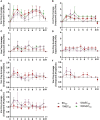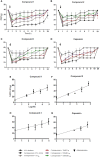Novel TRPV1 Channel Agonists With Faster and More Potent Analgesic Properties Than Capsaicin
- PMID: 32760273
- PMCID: PMC7372189
- DOI: 10.3389/fphar.2020.01040
Novel TRPV1 Channel Agonists With Faster and More Potent Analgesic Properties Than Capsaicin
Abstract
The transient receptor potential vanilloid 1 (TRPV1) ion channel is a member of the family of Transient Receptor Potential (TRP) channels that acts as a molecular detector of noxious signals in primary sensory neurons. Activated by capsaicin, heat, voltage and protons, it is also well known for its desensitization, which led to the medical use of topically applied TRPV1 agonist capsaicin for its long-lasting analgesic effects. Here we report three novel small molecules, which were identified using a Structure-Based Virtual Screening for TRPV1 from the ZINC database. The three compounds were tested using electrophysiological assays, which confirmed their capsaicin-like agonist activity. von Frey filaments were used to measure the analgesic effects of the compounds applied topically on tactile allodynia induced by intra-plantar carrageenan. All compounds had anti-nociceptive activity, but two of them showed faster and longer lasting analgesic effects than capsaicin. The present results suggest that TRPV1 agonists different from capsaicin could be used to develop topical analgesics with faster onset and more potent effects.
Keywords: TRPV1; allodynia; analgesic; capsaicin; carrageenan; drug discovery; transient receptor potential vanilloid 1 channels; von frey.
Copyright © 2020 Duarte, Cáceres, Sepúlveda, Arriagada, Olivares, Díaz-Franulic, Stehberg and González-Nilo.
Figures





References
LinkOut - more resources
Full Text Sources

